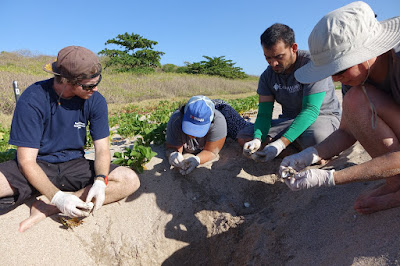I have such respect for the biologists who work here. At this station, most of the work is done at night, when the sea turtles are more likely to nest. Each night, patrols are sent out to walk the beach, and the hatchery is monitored to watch for hatchlings and guarded from predators. In the morning the entire length of the beach is walked to look for missed turtles.
Just because they are working at night doesn't mean there aren't things that need to be done during the day - nest temperatures are taken, old nests are excavated, and biologists work on their own research. Excavations happen about every other day, and it is hard work. If the marker for the nest has been lost (Playa Grande/Tamarindo is a public beach and one of the world's most famous surfing destinations), the nest has to be triangulated and then you basically just dig for treasure*. A leatherback nests 2-3 feet deep, so that is a LOT of sand to move. And don't forget, it's around 90° F every day.
*And by treasure, I mean rotten, decaying eggs filled with maggots or dead embryos.
I had an amazing 10 days here at the Goldring-Gund Marine Biology Station, living and working as a field biologist. Thank you so much to Earthwatch and the Leatherback Trust for the opportunity to come and share this project with my class, thanks to the biologists for making the experience absolutely life changing, and thanks to the turtles for opening my eyes to the importance of conservation and education.
THINGS I WILL NOT MISS ABOUT THE EARTHWATCH COSTA RICA SEA TURTLE PROJECT
1. Not showering. For 9 days.
2. That bleary-eyed, fuzzy headed feeling you get after not getting in a nap and patrolling all night:
 |
| Dean and me post-patrol, 2:45 AM |
3. Sand in crevices. ALL the crevices.
4. Watching Nathan pop my blisters:
 |
| Hey, he IS technically a doctor......! |
5. That millisecond after you open a bad one and the stench hits you:
 |
| Amy, searching for treasure |
7. Not flushing the toilets during daylight hours because there's no running water.
9. Putting on the same dirty shirt and pair of pants. Again. For the 7th night in a row.
THINGS I WILL MISS ABOUT THE EARTHWATCH COSTA RICA SEA TURTLE PROJECT
1. Having this as an office:
 |
| Nathan and me, Facetiming with my class back at LPCH |
 |
| Justine, working on her blog |
2. That moment on night patrol when your biologist freezes, and you realize the dark shape up ahead is a leatherback turtle.
3. This view:
 |
| Orion, helping us guard the hatchery |
4. And this view:
 |
| An afternoon relaxing at Pirate's Bay beach |
5. The sound of howler monkeys in the early morning.
6. Giggling all the way down the beach. (Lauren, Dean, and Amy, I'm talkin' to you!!)
7. Trading for all the papaya (thanks Brett!!)
 |
| Getting a plate of fresh fruit every morning for breakfast! |
8. Logic puzzles on night patrol. (And annoying the crap out of Collin!)
9. Watching Nathan and Sean polishing off EVERYONE's dinners:
10. These guys:
 |
| Biologists Lauren, Nathan, Sean, Collin, Lia, Jay, and Brett |
11. These guys:
 |
| Adrian, Dean, Suzanne, me, Mili, Justine, Amy, and Beatrice |
12. And especially these guys:








































